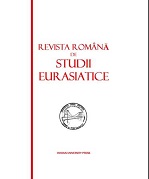ALEXANDRU MARHILOMAN GOVERNMENT’S RELATIONS WITH THE ENTENTE AND THE INITIALLING OF PEACE TREATY WITH THE CENTRAL POWERS IN BUCHAREST (APRIL 24th / MA
ALEXANDRU MARHILOMAN GOVERNMENT’S RELATIONS WITH THE ENTENTE AND THE INITIALLING OF PEACE TREATY WITH THE CENTRAL POWERS IN BUCHAREST (APRIL 24th / MA
Author(s): Mirabela Eleonora Tufan, Hadrian GorunSubject(s): History
Published by: Ovidius University Press
Keywords: peace treaty; alliance; King Ferdinand; Entente; Central Empires; World War I.
Summary/Abstract: As its title suggests, this study points out the relations between the Romanian government led by the conservative statesman Alexandru Marghiloman and the Allied countries. The situation of Romania was very difficult at the end of 1917 and at the beginning of 1918. Russia signed the armistice in Brest-Litovsk in December 1917 and later, on 3rd March 1918, the peace with the Central Powers in the same place. In February, Ucraina also gave up to fight and ceased to represent a buffer zone for the Romanian Kingdom. Surrounded by hostile forces, (the Bolshevik Russia and the armies of the Central Empires) the Romanian authorities did not face the ultimatum sent by the German General August von Mackensen. So Romania accepted the peace of Buftea on 20th February/ 5 March 1918. The new government strove to keep cordial relations with the powers of the Entente although it could not avoid the peace with Germany and its allies. The military resistance had become impossible because of the lack of ammunitions. The states of the Entente were able only to give their verbal support to Romanian authorities and sovereigns. Although the minister of the foreign affairs Virgil Arion had always adopted a conciliatory position to the Entente, the cabinet led by Marghiloman had many germanophil members. This is another reason for which the treaty of peace was only a matter of time. However, the Romanian government and the French minister at Iaşi decided to keep a French military mission after the departure of the mission of general Berthelot. At the beginning of April 1918, France and England decided that the diplomatic representatives of the Entente should continue their activity, even after the conclusion of peace. But Alexandru Marghiloman was sure that Central Powers would win the war. On the other hand, a few news concerning an agreement between the United States of America and the dual monarchy of Austria-Hungary worried the government of Bucharest. If the information was real, the agreement offered to double monarchy the whole freedom in the zone of the Balkans. The diplomacy of France insisted that the rumor should be denied. The chief of the Romanian government told to Allied representatives that Central Empires had not made any offer concerning a military cooperation in Russia. The Allies obtained alarming information about the will expressed by Germans to replace King Ferdinand. The Entente has always tried to oppose the conclusion of the peace. The Central Empires could use all their forces on the Western front. The Romanian cabinet presented the treaty of peace as the single way to save the state. There was no possibility for the Romanian army to continue the struggle. The treaty of peace between Romania and Central Empires was signed on 24th April/7th May 1918 in Bucharest, at Cotroceni Palace by the Romanian prime–minister Alexandru Marghiloman, von Külmann representing Germany, Istvan von Burian rep
Journal: Revista Română de Studii Eurasiatice
- Issue Year: 9/2013
- Issue No: 1+2
- Page Range: 63-74
- Page Count: 12
- Language: English
- Content File-PDF

